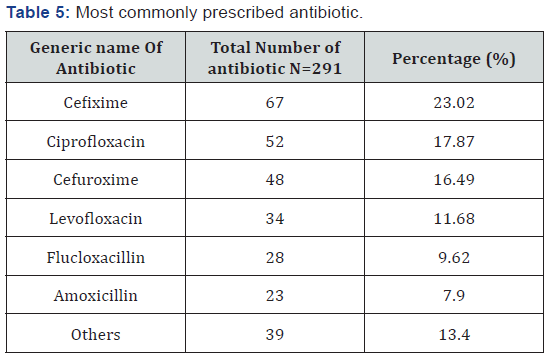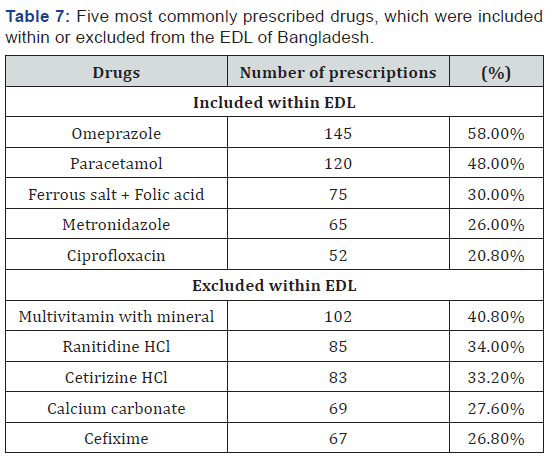Complementary Medicine & Alternative Healthcare - Juniper Publishers
Abstract
This study was carried out to find the
medicine-prescribing pattern in outpatient department of Medicine,
Surgery, Gynecology and Obstetrics in government and private hospitals
in Faridpur city, Bangladesh. To see the patterns of prescriptions of
250 patients were collected over a period of three months and analyzed
for the average number of drugs per prescription, number of drugs
prescribed per prescription, most common diagnosis, most commonly
prescribed antibiotics, most commonly prescribed groups of drugs,
percentage of drugs prescribed by generic names, percentage of drugs
prescribed from Essential Drug List (EDL) of Bangladesh. The average
number of medicines per prescription was 4.14 and 48.8% patients were
prescribed up to 3 medicines. Only 37.I6% drugs were prescribed from EDL
of Bangladesh. Percentage of encounters with an antiulcer ant, a NSAID
and a multivitamin & mineral prescribed were 29.25%, 18.15% and
9.84% respectively.
Keywords: Prescribing pattern; Essential drug; Antibiotic; Faridpur city; Rational use of drug
Introduction
Knowledge of risk perceptions has demonstrated to be
vitally important in understanding how individuals and societies manage
the risks of daily life. In medicine perceptions of drug risks are
probably to influence patients’ treatment decisions, their compliance
with treatment regimens, their views on the acceptability of adverse
reactions and the drugs that cause them, and their attitudes toward
government regulation of medications. Understanding perceptions is a
prerequisite for designing better communication materials for patients
and the general population [1]. The drug use process can be separated
into four fundamental components, namely: prescribing, dispensing,
administration/ uptake and outcome (efficacy/safety) [2]. The evaluation
of medication use is vital for clinical, educational and economic
purposes [3]. Monitoring of prescriptions and drug utilization study
could distinguish the related problems and give feed backs to the
prescriber in order to make awareness for the rational use of drugs [4].
It is therefore necessary to define the prescribing pattern and target
the irrational prescribing habit for sending a remedial message [5].
Therefore, the present study has been
undertaken to observe the prescribing patterns of Antibiotics and the
usage of these agents in different types of patients with different
types of diseases in Faridpur City of Bangladesh
Materials and Methods
Study area, duration of research project and data
collection process. A cross-sectional study was conducted in order to
evaluate prescription pattern of antibiotic drugs in patients with
various infectious diseases. On the basis of inclusion and exclusion
criteria prescriptions were collected from all patients (both male and
female) attended the outpatient (OPD) at government and private
hospitals in Faridpur city. The study was carried out over 90 days
period of April 15th, 2018 to July 15th, 2018. A total of 250 patients
were included in the study. New patients attending the outpatient
department of Medicine, Surgery and Gynecology and Obstetrics in
government and private hospitals in Faridpur city during the study
period were considered for analysis. Follow up visits during the study
period were included and were counted as separate visits. Patients
visiting the emergency department or who got admitted during OPD visit
were not included in the study. The average number of drugs
per prescription, number of drugs prescribed per prescription,
most common diagnosis, most commonly prescribed antibiotics,
most commonly prescribed groups of drugs, percentage of drugs
prescribed by generic names, Percentage of prescriptions with
injectable preparations., percentage of drugs prescribed from
Essential Drug List (EDL) of Bangladesh, The data was expressed
as percentage, mean and total numbers
Results

Total number of 250 medical case records were collected,
scrutinized and analyzed for drug prescription. The majority of
the patients were male 157 (62.80%) and 93 (37.2%) patients
were female with 14.80% of them aged between 18-50 years
Table 1.

In this research project, A total of 1036 individual drugs were
prescribed for 250 drug encounters, giving an average of 4.14.
The range of drugs per encounter varied from 1-7. There was not
a single prescription wherein no drug was prescribed. Moreover,
very few drugs were prescribed by generic name (1.93%). These
data are represented in Table 3

Total number of drugs in our prescription was 1036.
Among these, the most prescribed drugs were of acid related
preparations (29.25%). Then the second most prescribed drugs
were antibiotics (28.09%) Table 4.

At least one antibiotic was prescribed in 184 (73.6%) of the
250 encounters and 77 prescription contain single antibiotic
with other drugs. The most prescribed antibiotic was of cefixime
67 (23.02%). Then the second most prescribed antibiotics
ciprofloxacin (17.87%) Table 5.

Among 1036 drugs only twenty drugs (1.93%) were
prescribed by generic names. It was also seen that out of 250
prescriptions only 385 drugs (37.16%) were prescribed from the
EDL of Bangladesh Table 6.

The present study also shown that omeprazole 58% and
multivitamin with mineral 52% were prescribed among essential
and non-essential drugs. The five most commonly prescribed
drugs, which were included within or excluded from the EDL [6]
of Bangladesh Table 7.

Discussion
A prescription that is given by a doctor or physician is taken
as an indication of the doctor or physician’s attitude towards the
disease and the role of drugs in its treatment [7]. The central
priority of health care system is providing the right medicine to
the right people at the right time [8]. The source of data in these
study 250 medical cases was collected and the percentages of
male and female patients were 62.80% and 37.20%. Most of the
patients were above 50 years old. Similar results were obtained
from the previous study, which was conducted by Khan et al. [9].
This prospective study was conducted on 4800 patients who
visited the OPD and IPD of ENT department of Teerthanker
Mahaveer Medical Hospital and Research Centre of North India.
Their result indicated that higher percentage of male person
suffering from different infections.
We observed that in the data of this research project, most
of the patients were suffering from gastrointestinal disorders
(51.20%) and orthopedic disorder (26.00%). It is important to
note that drugs should be prescribed in their generic names to
avoid confusion. In this study the average number of prescribed
drugs were 4.14 and drugs were prescribed by generic name is
1.93%. It also showed that 80.08% patients were given three or
more drugs. The variation in results may be due to difference
in characteristics of health care delivery system, morbidity and
mortality characteristics in the population. Since, WHO has
recommended that average number of drugs per prescription
should be 2.0 [10], the results of the study reflect polypharmacy
which may lead to adverse drug reactions, increase the risk of
drug interactions, dispensing errors, decrease adherence to drug
regimens and unnecessary drug expenses.
Antiulcerant drugs, 207 prescriptions (69%) were found
and the omeprazole [148 prescriptions (49%)] was the most
commonly prescribed of this class. The present observation
remarked that 73.60% prescription contained antibiotic drugs
along with other drugs. Among 41.85% prescription contained
single antibiotic drug and 58.15% contained two antibiotic
drugs. No prescription contained more than two antibiotic drugs.
Prescriptions among which antibiotics that lie under Cefixime,
Ciprofloxacin were most commonly prescribed. Similar results
were obtained from the previous study, in Iran (61.9%) [11]. In
another study by Biswas et al revealed that mostly prescribed
drugs were also antibiotics (49.22%) [12]. According to WHO
15- 25% of prescriptions with antibiotics are expected, where
infectious diseases are more prevalent [13]. In a 3rd world
developing country like Bangladesh, prevalence of infectious
diseases is higher than the developed countries. That is why; in
this study the antibiotic utilization rate was higher than that of
developed countries. However, this result does not indicate that
the prescription pattern was better than in other countries.
The WHO recommended target for injection exposure is 10%
or less [14]. In this study, the percentage of prescription with
an injection encountered was 2.32% which is less than in Nepal
(3.1%) [15], Zimbabwe (13%) [16] and India (13.6%) [17]. so,
the observed proportion of injectable drugs prescribed may be
considered acceptable according to WHO recommendations.
Minimum use of injections is preferred, and this reduces the risk
of infection through parenteral route and cost incurred in therapy
[15]. It also showed that out of 250 prescriptions 102 (40.80%)
had at least one multivitamin and multimineral prescribed
which was not enlisted in EDL. The justification for this practice
is not clear. However, some patients and doctors believe that the
multivitamin supplement may induce or enhance the patient’s
appetite or relief from weakness. In this study, the percentage
of drugs prescribed from EDL of Bangladesh was 43.16%. The
possible reason for this lower value could be the prescribers
lacking the understanding the importance of essential drug
concept. The low rate of prescribing from EDL of Bangladesh
may be also contributed by excessive use of multivitamin and
multiminera, antiulcerant (Ranitidine) and antihistamine
[Cetirizine HCl], which are not enlisted in EDL of Bangladesh. So
that the higher percentage of non-essential drugs in this study is
responsible for inappropriate use of medicines.
Conclusion
Physician is often considered to be God and
therefore when a
doctor gives an antibiotic to a patient, it is taken without question.
However, a doctor is often pressurized to give antibiotics for a
variety of reasons. It could be due to the pressure of making a
patient well as soon as possible, or the fear of losing patients
to another doctor. Patients often demand powerful treatments,
and then there is the industry pressure and incentive schemes,
and, most importantly, the doctor`s own clinical judgment
skills. To be fair, many doctors work with inadequate and
unreliable investigational facilities. This may promote the
use of combination antibiotics and defensive medicine. From
the result of this study, it can be concluded that inappropriate
drug prescribing, inappropriate use of drugs and irrational
prescribing of antibiotic are major problems. Therefore, there is
a need strict enforcement and adherence to existing regulations
regarding antibiotic practices. To overcome these problems, the
drugs control authorities should be better equipped and more
vigilant to cope with the present situation. Health professionals
and drug manufacturers should be more committed in order to
achieve the goals of the National Drug Policy of Bangladesh.
To know more about Complementary Medicine & Alternative Healthcare
Click here: https://juniperpublishers.com/jcmah/index.php
To know more about Juniper Publishers
Click here: https://juniperpublishers.com/index.php





No comments:
Post a Comment